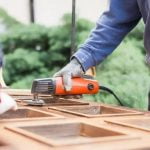When it comes to painting woodwork, many people mistakenly assume that the most crucial step is selecting the right paint color or investing in high-quality brushes. However, before you even think about reaching for that paintbrush, it is essential to properly clean the woodwork surface. Cleaning woodwork before painting is a critical step that should never be overlooked or rushed.
The significance of cleaning woodwork before painting cannot be emphasized enough. Not only does proper cleaning ensure a smoother and more even paint application, but it also improves the overall durability and longevity of the finish. By removing dirt, grime, grease, and other contaminants from the surface, you create an ideal canvas for successful paint adhesion. This means that your carefully chosen color will adhere better to the woodwork and withstand everyday wear and tear.
One of the key benefits of thoroughly cleaning woodwork before painting is that it allows for better surface preparation. Wood surfaces can accumulate years’ worth of dust, debris, and built-up residue over time.
By cleansing these surfaces thoroughly, you eliminate potential obstacles such as rough spots or imperfections that could interfere with achieving a smooth and professional-looking finish. Additionally, by addressing any existing paint or stain on the woodwork earlier in the process, you can ensure a clean slate for your new coat of paint.
With these points in mind, it becomes clear just how important cleaning woodwork before painting truly is. In the following sections, we will guide you through the necessary steps to achieve a clean canvas for your painting project. From gathering essential materials and preparing the surface to addressing different types of woodwork and tackling mold and mildew issues – by following our advice, you will be one step closer to achieving a pristine finish on your painted woodwork.
Gathering the necessary materials and tools
Checklist of Essential Items
Before embarking on the process of cleaning woodwork before painting, it is vital to gather all the necessary materials and tools. Having everything prepared beforehand will ensure a smooth and efficient cleaning process. Here is a checklist of essential items you will need:
- Cleaning detergent or solution: Choose a gentle cleaning detergent or specialized wood cleaner suitable for your specific type of woodwork. Avoid using harsh chemicals that could damage the wood.
- Soft cloths or sponges: Use soft cloths or sponges to avoid scratching or damaging the wood surface during cleaning.
- Bucket: Fill a bucket with warm water to dilute the cleaning detergent and create a soapy mixture for effective cleaning.
- Scrub brush or toothbrush: Depending on the severity of dirt buildup, a scrub brush or toothbrush can be used to reach into corners and crevices for more thorough cleaning.
- Safety gear: Protect yourself by wearing gloves, safety goggles, and a face mask to prevent any potential skin irritations from chemicals and dust particles.
- Plastic wrap or drop cloths: To protect surrounding surfaces from accidental spills or splatters when cleaning, cover them with plastic wrap or drop cloths.
- Sandpaper: If you plan on sanding the woodwork afterward, it’s recommended to have different grits of sandpaper ranging from coarse to fine, such as 80-grit, 120-grit, and 220-grit.
Recommended Cleaning Products
While there are various products available in the market for cleaning woodwork, it is important to choose ones that are effective yet gentle enough not to cause any damage. Here are some recommended cleaning products:
- Murphy’s Oil Soap: Known for its effectiveness in removing dirt and grime from wood surfaces, this soap is particularly suitable for natural woods like oak or pine.
- Simple Green All-Purpose Cleaner: This versatile cleaner is safe to use on different types of wood surfaces, including painted, stained, or varnished wood.
- White vinegar solution: Mixing equal parts of white vinegar and water can create an effective cleaning solution for eliminating tough stains and grease from woodwork.
- Commercial wood cleaners: There are specialized wood cleaners available in the market that cater to specific types of wood, such as teak or mahogany. These products often come with detailed instructions for proper usage.
Remember to read the labels and follow the manufacturer’s instructions when using any cleaning products. It’s also a good idea to test any new product on a small inconspicuous area before applying it to the entire woodwork surface. Having all the necessary materials and tools ready will ensure a successful cleaning process and ultimately lead to a perfectly primed surface for painting.
Preparing the woodwork surface
Removing Existing Paint or Stains
One essential step in preparing the woodwork surface for painting is to remove any existing paint or stains. This ensures that the new coat of paint adheres properly and provides a smooth, even finish. There are several methods you can use to strip the old paint or stain from the wood.
One popular technique is using a chemical paint stripper. Begin by applying the stripper to the wood according to the manufacturer’s instructions. Allow it to sit for the recommended amount of time, usually around 15-30 minutes. Then, using a putty knife or scraper, gently scrape off the softened paint or stain. Repeat this process until all layers have been removed.
If you prefer a more environmentally friendly approach, you can use heat to strip off the old paint or stain. A heat gun is typically used for this method. Hold the heat gun about six inches away from the surface of the wood and move it back and forth until you see bubbles forming in the paint. Once bubbles appear, use a putty knife or scraper to scrape off the softened paint.
Addressing Rough Spots and Imperfections
Before proceeding with cleaning, it’s important to address any rough spots, nicks, or imperfections on the woodwork surface. These imperfections can affect how well the new coat of paint adheres and may be noticeable through the finished result.
To smooth out rough spots and imperfections, start by sanding them down with medium-grit sandpaper. Use gentle strokes in a circular motion until you achieve a smooth surface. After sanding, wipe away any dust with a clean cloth.
For deeper scratches or gouges, consider using wood filler. Apply an adequate amount of wood filler to fill in these areas, leaving it slightly raised above the surrounding wood surface. Allow it to dry completely before sanding it down to match the rest of the surface.
Now that the woodwork surface is free from old paint or stains and any imperfections have been addressed, it is ready for the cleaning process. Thoroughly cleaning the woodwork not only removes dirt, dust, and grime but also ensures a clean canvas for successful painting.
Cleaning techniques for different types of woodwork
When it comes to cleaning different types of woodwork before painting, it’s important to understand that each surface requires a specific approach. The cleaning method you use will depend on the type of wood and its current condition. Whether you are dealing with painted wood, stained wood, or varnished wood, here are some step-by-step instructions to help you achieve a clean canvas for painting.
For painted wood, start by removing any loose paint chips or flaking paint using a putty knife or scraper. Once the loose paint is removed, use warm soapy water and a soft-bristle brush to scrub away any dirt or grime.
Rinse the surface thoroughly with clean water and allow it to dry completely before moving on to the next step. If there are stubborn stains or grease marks on the painted wood, you can use a mild detergent or specialized cleaner formulated for painted surfaces.
When it comes to cleaning stained wood, take extra care as these surfaces can be sensitive to harsh chemicals. Begin by dusting the surface using a soft cloth or brush to remove any loose dirt or debris. Next, prepare a solution of equal parts vinegar and water and gently wipe down the stained wood using a soft cloth.
Avoid applying excessive pressure or soaking the wood as this can cause damage. Finish by rinsing the surface with clean water and drying it thoroughly.
Varnished wood requires special attention during the cleaning process. Start by wiping down the surface with a microfiber cloth to remove any dust particles. For more thorough cleaning, mix equal parts white vinegar and water in a spray bottle and lightly mist the varnished wood.
Wipe away the solution using a soft cloth in gentle circular motions, being careful not to press too hard or scrub vigorously. Once clean, rinse off any remaining residue with clean water and pat dry with a lint-free cloth.
Remember that regardless of the type of woodwork you are cleaning, always test any cleaning solution on a small inconspicuous area first to ensure it does not cause damage or discoloration. By using the appropriate techniques for each type of wood, you can ensure that your woodwork is properly cleaned and ready for a professional paint finish.
Removing dirt, dust, and grime from woodwork
When it comes to painting woodwork, one crucial step is removing dirt, dust, and grime from the surface. Properly cleaning the woodwork not only helps ensure a smooth paint application but also enhances the longevity of the finished product. In this section, we will discuss the importance of thorough dusting and dirt removal before cleaning and provide effective techniques for eliminating stubborn stains and dirt buildup.
Thorough Dusting:
Before beginning the cleaning process, it is essential to eliminate any loose dust or debris from the woodwork. Dust particles can interfere with paint adhesion and result in an uneven finish. Start by using a soft brush or vacuum cleaner with a brush attachment to remove as much loose dust as possible. Pay special attention to corners, crevices, and hard-to-reach areas.
Effective Cleaning Techniques:
Once you have removed the loose dust, it’s time to tackle any remaining grime or stains on the woodwork. The best approach will depend on the type of wood surface you are working with. Here are some step-by-step instructions for different types:
- Painted Wood: Use warm water mixed with mild dish soap and a soft sponge or cloth to gently scrub away any dirt or stains. Rinse thoroughly with clean water afterward.
- Stained Wood: Avoid harsh chemicals that may damage the stain. Instead, use a mixture of white vinegar diluted in water (1:1 ratio) and apply it onto a cloth or sponge. Gently rub the stained woodwork in circular motions until clean.
- Varnished Wood: Varnished surfaces should be cleaned using a specialized varnish cleaner recommended by manufacturers. Follow the instructions provided on the product label for the best results.
Dealing with Stubborn Stains and Buildup:
In some cases, you may encounter stubborn stains or dirt buildup that requires additional treatment. For sticky residue or wax buildup, use a mild solvent such as mineral spirits applied onto a clean cloth to gently remove the substance. Remember to test any solvents on an inconspicuous area first to ensure it does not damage the woodwork. For more challenging stains like ink or marker, consider using a commercial wood stain remover following the manufacturer’s instructions.
By thoroughly removing dirt, dust, and grime from your woodwork before painting, you are providing a clean canvas for a successful finish. Following these cleaning techniques will help ensure that your paint adheres properly and lasts longer. Now that we have covered this essential step in the cleaning process, let’s move on to addressing mold and mildew growth on wood surfaces in the next section.
Tackling mold and mildew on woodwork
Mold and mildew growth on woodwork can be a common issue, especially in areas with high humidity levels or poor ventilation. Not only can mold and mildew be unsightly, but they can also pose health hazards and compromise the integrity of the woodwork. Tackling mold and mildew before painting is crucial for achieving a clean canvas and ensuring a successful paint job.
To remove mold and mildew from woodwork, it is important to start by addressing the underlying cause of their growth. Moisture is typically the main culprit, so identifying and repairing any leaks or sources of excess moisture is essential in preventing future growth. Once this step is completed, you can proceed with removing the existing mold and mildew using appropriate cleaning methods.
Before starting the cleaning process, ensure that you wear protective gear such as gloves, a mask, and safety goggles to prevent any contact with mold spores or harsh cleaning chemicals. Additionally, make sure the area is well-ventilated to minimize exposure to fumes.
To remove visible mold or mildew from painted or stained woodwork, begin by gently scrubbing the affected areas with a mixture of water and mild detergent using a cloth or sponge. For stubborn stains, you may need to use a stronger solution such as a mixture of water and bleach (1 part bleach to 3 parts water).
However, exercise caution when using bleach as it may discolor certain types of wood surfaces. Test the solution on a small inconspicuous area first before applying it more broadly.
For varnished woodwork, avoid using bleach as it can damage the finish. Instead, opt for commercial products specifically designed for removing mold and mildew from wooden surfaces. Follow the manufacturer’s instructions carefully when using these products.
Once the mold and mildew have been removed successfully, thoroughly rinse the woodwork with clean water to remove any residue from cleaning solutions. Use a dry cloth or towel to wipe the surface dry. It is essential to ensure that the woodwork is completely dry before proceeding with any painting or refinishing tasks.
By following these steps, you can effectively tackle mold and mildew on woodwork, creating a clean and safe surface for painting. Taking proactive measures to prevent future growth, such as improving ventilation and addressing any sources of moisture, will help maintain the integrity of the woodwork and prolong its lifespan.
| Material/Equipment | Recommended Products |
|---|---|
| Protective Gear (gloves, mask, safety goggles) | – Nitrile gloves
|
| Cleaning Solution for Painted/Stained Wood | – Mild detergent
|
| Cleaning Solution for Varnished Wood | – Commercial mold and mildew remover specifically designed for wooden surfaces |
Sanding the woodwork for a smooth finish
Sanding is a crucial step in the process of cleaning woodwork before painting. It not only removes any existing paint or finish, but it also helps create a smooth and even surface for optimal paint adhesion. In this section, we will discuss the necessity of sanding and provide a step-by-step guide for sanding woodwork effectively.
Before starting the sanding process, gather the necessary materials. You will need sandpaper in various grits, ranging from coarse to fine. Coarse grits, such as 60 or 80, are ideal for removing old paint or varnish, while finer grits like 120 or 150 are used for smoothing out the surface. Additionally, consider using a sanding block or an electric sander for larger areas.
To begin sanding, make sure to wear protective goggles and a dust mask to avoid inhaling any particles. Start with the coarsest grit of sandpaper and move it back and forth along the grain of the wood. Apply gentle pressure and be consistent in your movements. Sand until all of the previous finish is removed or until you achieve a smooth surface.
After using the coarse grit, switch to a finer-grit sandpaper to further smoothen and refine the surface. Again, remember to follow the grain of the wood and apply even pressure throughout. You may need to repeat this process with progressively finer-grit sandpapers until you achieve your desired smoothness.
Once you have finished sanding, use a clean cloth or tack cloth to wipe away any dust or debris left from the process. This is essential before proceeding with any painting as it ensures that no loose particles interfere with paint application.
Precautions and safety measures
When it comes to cleaning woodwork before painting, it is important to prioritize safety. There are several precautions and safety measures that should be taken to ensure a safe and successful cleaning process.
Firstly, it is crucial to wear proper protective gear. This includes gloves, safety glasses or goggles, and a dust mask or respirator. These items will protect you from any potential hazards such as chemicals, dust particles, or paint residue. It is also recommended to wear old clothing that you don’t mind getting dirty or stained.
Secondly, proper ventilation is key during the woodwork cleaning process. Many cleaning products contain chemicals that can release harmful fumes. Ensure that the area you are working in is well-ventilated by opening windows and doors or using fans. If you are working in a confined space without good airflow, consider using respiratory protection or choosing alternative products with less chemical fumes.
In addition to personal safety, it is important to protect the surrounding areas. Place drop cloths or plastic sheets on the floor and over any furniture nearby to prevent damage from spills or drips. If possible, remove any delicate items from the vicinity of the woodwork being cleaned.
Lastly, be cautious when handling hazardous chemicals. Read and follow all instructions provided by the manufacturer of the cleaning products you are using. Store these products out of reach of children and pets, and properly dispose of any leftover chemicals according to local regulations.
By taking these precautions and safety measures, you can ensure a safer woodwork cleaning process while minimizing potential risks and hazards.
| Precautions | Safety Measures |
|---|---|
| Wear proper protective gear (gloves, safety glasses, dust mask) | Ensure good ventilation (open windows/doors/use fans) |
| Protect surrounding areas with drop cloths or plastic sheets | Read and follow instructions provided by the manufacturer |
| Handle hazardous chemicals with caution | Store chemicals out of reach of children and pets |
Conclusion
In conclusion, properly cleaning woodwork before painting is essential for achieving a successful and long-lasting finish. By following the outlined steps and techniques in this guide, you can ensure that your wood surfaces are free from dirt, grime, mold, and imperfections, providing a clean canvas for your paint job.
Thoroughly cleaning the woodwork not only improves the overall appearance of the finished project but also enhances its durability. Removing dirt, dust, and other contaminants ensures that the paint adheres properly to the surface, preventing peeling or cracking over time. Additionally, addressing any rough spots or imperfections on the woodwork allows for a smoother and more professional finish.
Furthermore, proper cleaning techniques prevent mold and mildew growth on wood surfaces. Mold and mildew can not only damage the wood but also pose health risks to those living in the space. By addressing these issues prior to painting, you can eliminate existing mold or mildew and take preventive measures to avoid their recurrence.
In summary, achieving a clean canvas is crucial for successful painting on woodwork. By following the steps outlined in this article and taking necessary precautions along the way, you can ensure a professional and long-lasting finish that enhances the beauty and durability of your wood surfaces. So before you begin your next painting project on woodwork, make sure to dedicate ample time to thorough cleaning – it will be well worth it in the end.
Frequently Asked Questions
What is the best way to clean wood before painting?
The best way to clean wood before painting is to start by removing any loose dirt or dust from the surface. This can be done by using a soft brush or a vacuum cleaner with a brush attachment. Next, prepare a mixture of mild soap and warm water and dampen a sponge or cloth with this solution.
Gently scrub the wood surface, being careful not to soak it excessively. Rinse the surface with clean water and allow it to dry completely before proceeding with the painting process. It is important to note that if there are any stubborn stains or areas of discoloration, sanding may be necessary prior to cleaning.
How do you remove grease from wood before painting?
Grease can be quite challenging to remove from wood surfaces, especially before painting. To tackle grease stains effectively, start by blotting up as much of the grease as possible using paper towels or clean rags. Avoid rubbing the grease, as it may spread further into the wood pores.
Once the excess is removed, sprinkle an absorbent material such as cornstarch or baking soda onto the stained area and leave it for about 15 minutes. Gently scrub the stained area with a soft-bristled brush dipped in warm soapy water (mild dish soap works well) until the grease stain is lifted. Rinse thoroughly with water and allow the wood to dry completely before proceeding with your painting project.
What is the best solution to clean woodwork?
The best solution for cleaning woodwork depends on its condition and type of finish but generally involves a gentle approach that doesn’t cause damage or leave residue behind. Start by dusting off any loose dirt or debris using a soft brush or vacuum cleaner with a brush attachment. Next, prepare a mixture of warm water and mild dish soap in a bucket or bowl. Dampen a soft cloth or sponge in this solution and gently wipe down the wood surfaces, ensuring not to apply excessive moisture that could damage or warp the woodwork.
For stubborn grime or marks, a slightly stronger cleaning solution may be required, such as a mixture of water and white vinegar or specialized wood cleaner. Before using any cleaning products, it is recommended to test them on a small inconspicuous area first to ensure they don’t negatively affect the finish. Rinse the woodwork thoroughly with clean water after cleaning and allow it to air dry or use a soft cloth to pat it dry.

Hi everyone! I’m a woodworker and blogger, and this is my woodworking blog. In my blog, I share tips and tricks for woodworkers of all skill levels, as well as project ideas that you can try yourself.





